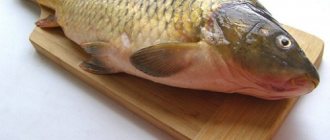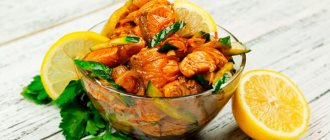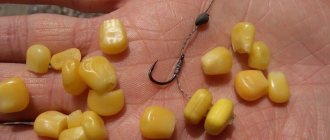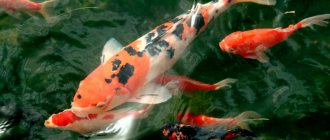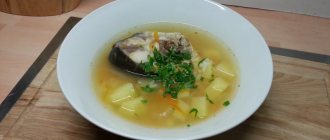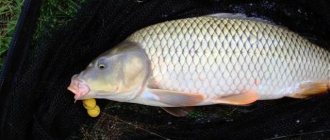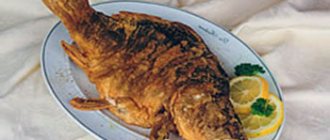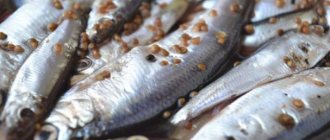Carp is a fish of the ray-finned class of the Cyprinidae family. Found in rivers and lakes of Europe, Asia, and North America. It prefers a warm environment, so it stays at a depth of 3–10 meters. They leave for spawning in May, when the water warms up to 18 degrees. There is some debate about the origin of the fish. Some researchers claim that carp is a domesticated type of wild carp.
As a result of a sedentary lifestyle, carp have developed a massive body with a wide back and a narrowed head (see photo). The fish has antennae on its upper lip that help it find food. The backs are grayish or brown, the sides are cast in gold. Carps live on average 30–35 years and reach 20 kg.
Fish are omnivores, quickly reproduce and gain weight, and adapt to a lack of oxygen and a dirty environment. These qualities have made freshwater animals popular subjects for aquaculture and breeding. Individuals are raised in artificial ponds for sale and paid fishing. In nurseries they are able to gain a weight of 40–50 kg.
Carp meat has a sweetish taste and can be subjected to different types of processing, but its main advantage is its beneficial properties. The product is recommended to be used for recovery from illness and to prevent pathologies of internal organs and systems.
From the article we will learn about the health benefits of fish, its possible harm, and the peculiarities of preparation and consumption.
Types of carp
Waterfowl are similar in structure, meat composition, and habitat. The main difference between fish is their scaly cover. Brief description of the species:
- Common or carp. In Latin - Cyprinus carpio. It is often classified as a separate type of fish. It belongs to river inhabitants that prefer reservoirs with strong currents, therefore it has a less massive body.
- Gold. A common species, it is considered domesticated carp. Completely covered with scales.
- Siamese or giant barbel. The largest of the family. Reaches 1.5 m in length, weight - 45 kg. It feeds on aquatic plants and phytoplankton.
- Mirror. It is distinguished by the presence of rare large scales. It is not often found in nature, as it grows slowly. Artificially grown individuals are the fattest among cyprinids.
- Japanese or Koi. Decorative look. It has bright colors - red spots on a white background. Bred to decorate large aquariums and artificial reservoirs.
- Naked. Appeared as a result of the work of breeders with mirror carp. Deprived of scales, the body is protected by dense mucus. It has weak immunity and is more often exposed to parasites than other species.
- Ghost. Developed by English specialists. Has high resistance to infections.
Carp in natural habitat
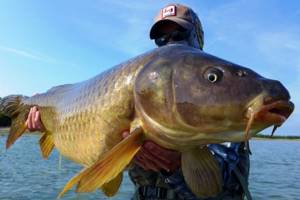
Common carp or carp (Cyprinus carpio)
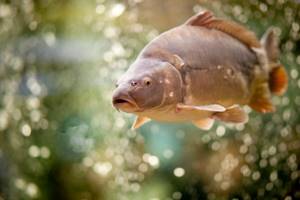
Naked or Leatherback Carp
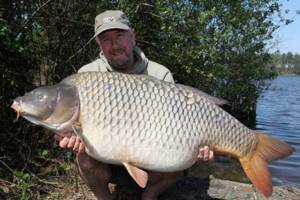
Mirror carp: classification
This fish is a domesticated carp, which differs from its subspecies in its naked body: its scales are either completely absent or scattered throughout the carcass in places.
Mirror carp is quite large: adult individuals reach 1-1.5 meters and can weigh up to 20-25 kg. The lifespan of this fish is on average 20 years. Carp does not have a stomach and takes food continuously. Thanks to this, as well as its omnivorous nature, the meat of this fish is very fatty and tasty. To catch carp, anglers recommend purchasing a float rod with a powerful rod. To catch a large individual weighing more than 10 kg, you cannot do without using a thick leash (minimum 0.7 mm).
Beneficial properties of carp meat and caviar
Fish contains vitamins and minerals necessary for the functioning of all human systems and organs. It has an antioxidant, anti-inflammatory, and tonic effect. Both meat and carp caviar have beneficial properties. The difference in products is the concentration of active elements and the speed of their absorption. The fillet takes longer to digest. Caviar releases vitamins, amino acids and minerals faster and in greater quantities.
Why carp is useful:
- Normalizes hematopoietic function.
- Prevents exhaustion of the body.
- Cleanses the liver of toxins.
- Resists cell destruction and activates restoration processes.
- Accelerates the removal of harmful cholesterol.
- Prevents premature aging.
- Prevents the development of endocrine pathologies.
- Strengthens bones.
- Supports brain activity.
- Protects against the effects of free radicals.
- Improves the functioning of the gastrointestinal tract.
- Helps reduce blood sugar.
- Strengthens the walls of blood vessels.
- Maintains normal blood pressure levels.
- Reduces the risk of developing colds.
- Improves the condition of skin and hair.
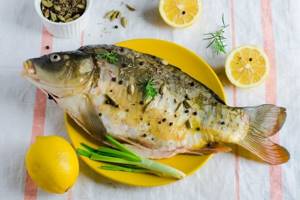
Contraindications, possible harm
Contraindication for use: allergy to fish. The product should also not be eaten by people with intolerance to the substances included in its composition. A healthy person can eat 100–150 g of meat per day, 2–4 times a week. The daily norm for caviar is 50–70 g.
Fish must be thoroughly cooked, as carp often become carriers of parasites. When consuming an improperly prepared product, a person can become infected with helminths.
Carp fish grown in artificial conditions can do more harm to the body than good. Causes:
- In ponds, individuals are given high-calorie supplements to accelerate growth. Such food increases the amount of fat in the product and provokes the accumulation of cholesterol, which is harmful to humans.
- When a reservoir is overpopulated, the likelihood of developing bacteria dangerous to fish increases, so antibiotics can be added to the feed, which penetrate into the meat. Eating foods saturated with drugs leads to weakened immune defenses and food poisoning.
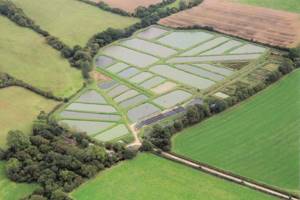
Artificial reservoirs for breeding and growing carp
Spawning and feeding habits
Carp spawning begins after the water temperature rises significantly and becomes stable. The spring flood forces this representative of the aquatic fauna to leave its winter camp and begin intensive preparation for the upcoming spawning. About four weeks before this process, carp form small schools at a depth of 2 meters, and if the temperature is set at 18-20 degrees, then they begin to spawn. During this period, near the shore, you can notice frisky movements and splashes, indicating the spawning of fish. The eggs mature in four days.
Carp are classified as omnivorous aquatic inhabitants that can feed on both plant and animal foods . The fish is not particularly picky about the choice of food, but it gains height and weight very quickly. Within a few years, the favorite trophy of many fishermen reaches impressive sizes, turning into a desired prey.
If an individual feels alarmed, it makes frequent crackling noises and goes into the depths.
Pregnant and lactating
It is beneficial for women to eat fish while pregnant. Substances contained in carp help prevent the development of anemia, pressure surges, insomnia, irritability, and promote the formation of the fetal neural tube.
Pregnant women are allowed to use the product once a day, twice a week. Fish should be steamed, baked or boiled. Fried food is harmful; it creates additional stress on the stomach and intestines, causing heartburn and flatulence.
When breastfeeding, carp can also be included in the diet. Beneficial compounds from fish penetrate into milk, so the child receives vitamins and microelements necessary for growth. But you need to monitor your baby’s reaction to the product. If signs of an allergy appear, the carp should be discarded or replaced with another species of waterfowl.
Fried carp “Boneless”
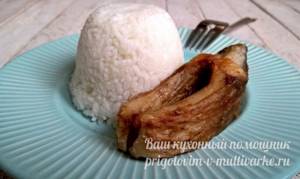
Who among us doesn’t love fried carp – a fish with perfect taste, quite healthy and juicy? However, carp dishes cannot be called overly popular.
The culprit is the notorious small bones, which spoil the entire impression of river fish. Okay, ribs - it’s hard to “miss” them. But is there really no effective way to get rid of the thin bones that force you to focus not on eating, but on extracting inedible components. Of course there is! And now we will tell you how to fry carp so that there are no small bones.
Ingredients:
- fresh carp – 1 carcass (best weight – from 1 to 1.5 kg);
- salt - to taste;
- flour for breading – 2 tbsp;
- vegetable oil for frying (preferably refined).

To process and prepare carp, you do not need any non-standard equipment: just a knife, kitchen scissors, a frying pan and a board for cutting fish.
Is it possible for children
Carp is introduced into the diet from the age of 3 years. Fish is a medium-fat fish, and at an early age lean types are better digested. The downside of the product is also that it is bony and should be given to children who can remove small elements on their own. Benefits of carp for a child’s body:
- saturation with easily digestible proteins;
- preventing the development of rickets;
- maintaining immunity;
- strengthening tooth enamel;
- memory improvement;
- rapid recovery of strength after physical activity.
How to deliciously cook boneless carp in the oven
Carp is considered a very bony fish; it especially has a lot of small bones, which cause a lot of inconvenience when eaten. But the meat is very tender, sweet and juicy. But to get rid of the bones, it is enough to spend some time during cooking to remove them.
It is recommended to use large fish, approximately 2 kilograms. It is much easier to pick out all the bones from a large carcass.
Boneless carp made according to this recipe turns out incredibly tasty. The main thing is to prepare all the components in the proportions indicated in the recipe. For preparation you will need the following ingredients:
- fresh carp, preferably live, weighing at least two kilograms;
- spices and seasonings intended for fish - 30-40 grams;
- 450-500 grams of premium wheat flour;
- to add a pleasant aroma, you can add ground black pepper; half a tablespoon will be enough;
- two heads of onions;
- potato tubers – 4-5 pieces;
- two fresh lemons;
- 380 ml vegetable oil;
- a glass of sour cream, it is better to use natural, rustic sour cream. If you use store-bought, it is better to take one with a high fat content, at least 20%;
- a piece of cheese (hard) per 100 grams;
- dried dill.
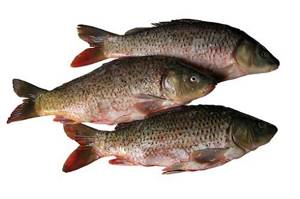
It is important to strictly follow the recipe; this will help you make a delicious treat for a family dinner or for a holiday table. For this reason, the first step is to properly clean the fish. First you need to use a sharp knife to remove all the scales. Also, do not miss the areas under the fins, because there are also small scales there. After removing the scales, rinse the fish thoroughly under cool water.
Next, we proceed to clean out the insides and carefully cut the abdomen. We carefully remove the giblets with our hands. After removing the entrails, rinse the carcass again. When washing, we pay special attention to the inside; it is imperative to remove all the dark film, otherwise the taste of the carp may deteriorate greatly.
Cooking features
Once the carp is cleared of scales and entrails, you can begin cooking. It is better to cut off the head, fins and tail; these parts will not be required. If you still decide to leave the head, then the recipe recommends removing the gills, because they can spoil the carp taste.
It is not necessary to remove the bones. To prevent them from being felt, it is enough to make cross-shaped cuts on the surface of the carcass. They are recommended to be performed on both sides. When baking, the bones will simply dissolve.
After the fish is cut, it needs to be rubbed with salt on top and inside. Place the carcass in a large cup. We wash the lemons and squeeze the juice out of one. Pour lemon juice over the carp and leave to marinate for about 15 minutes, but more often the recipe recommends leaving it in the marinade for half an hour.
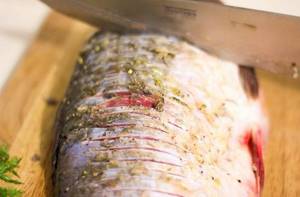
While the carp is marinating, prepare the remaining ingredients:
- peel the onion, it is better to rinse it with cold water, cut the heads into thin circles;
- a piece of cheese must be rubbed through a grater with a large grid;
- pour flour into a cup, add fish spices, dill, add vegetable oil and stir so that the spices are evenly distributed throughout the mixture;
- the result should be a thick flour paste;
- peel the potato tubers, wash them well, the peeled potatoes can be placed in cold water so that there are no dark spots on the surface;
- Cut the remaining lemon into thin slices.
Forming and baking
After all the ingredients are ready and the carp is marinated, you can begin to form the dish and bake it. The baking dish or baking sheet must be thoroughly coated with vegetable oil on all sides.
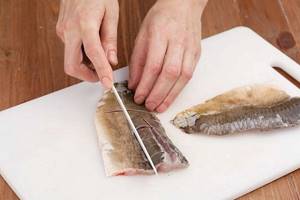
The formation process is carried out according to the following scheme:
- Divide the flour mixture into two parts, place one part on the bottom of the mold in an even layer;
- place the chopped onion slices on top of the flour base, they should completely cover it;
- Place lemon slices in a thick layer on top of the onion; they will add additional flavor and juice to the fish;
- Next we make a mixture for rubbing the carp. Sour cream needs to be mixed with vegetable oil; 70 ml of oil will be enough for a glass of sour cream;
- marinated carp should be rubbed on all sides and inside with sour cream sauce;
- place the fish on a tray, spread the remaining sauce;
- peeled potatoes must be cut into small slices with a thickness of no more than 3 mm;
- place potato pieces on top of the fish;
- The potatoes should cover the carp in an even layer.
Chemical composition, calorie content
Studies of the composition of fish have shown that it contains amino acids, omega-3 and omega-6 fatty acids, and sterols. Amount of vitamins per 100 g of product:
- A (retinol) - 0.19 mg;
- B1 (thiamine) - 0.14 mg;
- B2 (riboflavin) - 0.055 mg;
- B4 (choline) - 65 mg;
- B5 (pantothenic acid) - 0.19 mg;
- B6 (pyridoxine) - 0.17 mg;
- B9 (folate) - 9.29 mcg;
- B12 (cobalamin) - 1.45 mcg;
- D (calciferol) - 24.69 mcg;
- C (ascorbic acid) - 1.49 mg;
- E (alpha tocopherol) - 0.49 mg;
- K (phylloquinone) - 0.1 mcg;
- PP (nicotinic acid) - 5.49 mg.
Saturation of carp with macroelements per 100 g of product:
- potassium - 265 mg;
- phosphorus - 210 mg;
- sulfur - 180 mg;
- sodium - 55 mg;
- chlorine - 55 mg;
- calcium - 35 mg;
- magnesium - 25 mg.
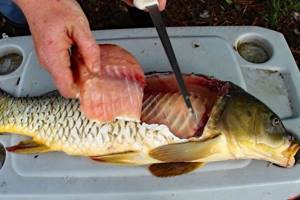
100 g of fish contains the following microelements:
- zinc - 2.1 mg;
- iron - 0.8 mg;
- manganese - 0.15 mg;
- copper - 130 mcg;
- chromium - 54.67 mcg;
- cobalt - 34.9 mcg;
- fluorine - 25 mcg;
- selenium - 12.58 mcg;
- nickel - 6.87 mcg;
- iodine - 4.82 mcg;
- molybdenum - 4 mcg.
The protein content in fish meat is 16%, in caviar - 26%, fat in fillet - 5-6%, in caviar - 3-8%, no carbohydrates were found. 77% of the carp carcass consists of water, ash in the product is 1.3–1.5%. Calorie content depends on the cooking method. 100 g of raw fish contains 112 kcal.
Energy value for different types of processing:
| Cooking method | Kcal per 100 g |
| Cooking | 101 |
| For a couple | 105 |
| Baking | 124 |
| Frying with oil | 197 |
| Grilling | 162 |
| Extinguishing | 110 |
| Salting | 138 |
| Drying | 221 |
| Smoking | 112 |
| Canning | 142 |
| Milk | 90 |
| Caviar | 131 |
Is milk and carp fat healthy?
Fish milk and fat also have medicinal properties. The seminal glands help eliminate inflammatory processes, thin the blood, and increase endurance. For men, the product helps improve potency, and for women, it helps prevent the early appearance of wrinkles.
Fish oil is rich in antioxidants, vitamins A and D, and omega-3 acids. Its use can reduce the likelihood of cancer, maintain visual acuity, and eliminate bone fragility. The product is used to make dietary supplements and cosmetics with a rejuvenating effect.
Differences from carp, crucian carp, bream, silver carp, carp
Freshwater fish, according to biological taxonomy, belong to the same family, are similar in chemical composition and effects on the body, but there are also features:
- Grass carp feeds on vegetation, and therefore contains fewer micro and macroelements than other cyprinids. However, it is superior to fish in phosphorus concentration, and quickly helps eliminate bone fragility and tooth enamel sensitivity.
- Carp or common carp has a high iodine content. The product is useful for endocrine diseases.
- Silver carp is the only freshwater carp that contains fat, like marine representatives. Fish quickly eliminates high blood pressure and excess cholesterol.
- Bream is superior to carp in the amount of protein in meat, but contains fewer vitamins.
- Crucian carp is the least high-calorie fish, but the bony one. It has a pronounced sweetish taste.
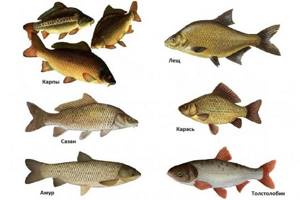
Fried carp “Boneless”
Who among us doesn’t love fried carp – a fish with perfect taste, quite healthy and juicy? However, carp dishes cannot be called overly popular.
The culprit is the notorious small bones, which spoil the entire impression of river fish. Okay, ribs - it’s hard to “miss” them. But is there really no effective way to get rid of the thin bones that force you to focus not on eating, but on extracting inedible components. Of course there is! And now we will tell you how to fry carp so that there are no small bones.
Ingredients:
- fresh carp – 1 carcass (best weight – from 1 to 1.5 kg);
- salt - to taste;
- flour for breading – 2 tbsp;
- vegetable oil for frying (preferably refined).
To process and prepare carp, you do not need any non-standard equipment: just a knife, kitchen scissors, a frying pan and a board for cutting fish.
Benefits and harms for various diseases
If there is a pathology, you should consult a doctor before introducing fish into your diet. The recommendation is due to the fact that carp meat and caviar can be beneficial or harmful depending on the type and stage of the disease.
Examples of product impact:
- Diabetes. Fish helps maintain sugar and cholesterol levels at acceptable levels. The patient can eat carp 1-2 times a week. You need to choose wild individuals. Fish raised in captivity are fattier and may contain substances that are harmful to diabetics.
- Pancreatitis. Carp is useful for chronic pathology in remission. Helps prevent inflammation and facilitates digestion. During an exacerbation, fish is harmful, since the diseased organ cannot cope with the breakdown of fats.
- Gout. Carp is one of the products allowed for pathology. It helps improve metabolism, therefore reducing the risk of exacerbation. Boiled and steamed fish are healthy. You can eat 100 g of it 2 times a week during the period of remission. Increasing the dose and frequency of use leads to the accumulation of purines and deterioration of the patient’s well-being.
- Gastritis. The product helps support the functioning of the stomach and intestines, prevent complications, and speed up the recovery of the body. Fried, salted and smoked carp causes harm, as it irritates the mucous membrane and provokes an exacerbation.
Is carp fish bony or not?
What is the best way to cook it?
Carp recipes? How to cook delicious carp?
Carp is a river fish, so you need to be prepared to dig through the bones. This is especially true for the tail part of the carp; the body contains mainly rib bones; they are easier to reach. You also need to be careful about the ridge, there are small and sharp bones. I would like to note that if you cook carp constantly, the bones can be identified easily, from memory, and there will be no problems.
I like oven-baked carp stuffed with stewed carrots and onions. You can spread mayonnaise on top. It turns out juicy and fatty, it’s not a shame to even put it on the holiday table. It's easy to prepare, no need to stand over the frying pan and turn it over.
Carp is a freshwater fish. It is very useful because it contains valuable microelements.
Dishes prepared from this fish are juicy and have a pleasant taste. However, carp has a significant drawback - a very large number of small bones.
Experienced housewives advise when baking carp to make cuts on the fish, frequent transverse cuts or cross cuts: this will help you not to feel the small bones:
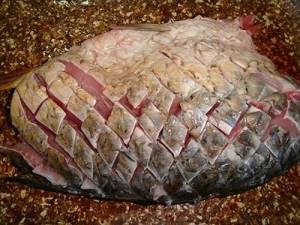
This way you can cook carp baked in the oven. To do this, rub the carp with salt, pepper and spices. Sauté the onions and carrots and place them in a baking dish.
Let's put our fish on top. Cover it with mayonnaise for juiciness. You can put tomato slices and herbs inside the carp.
Top the fish with a tablespoon of olive oil mixed with garlic and lemon juice. Place the dish in a well-heated oven to bake for 30 minutes.
Carp is a very tasty fish, especially large ones - at least 1.5-2 kg. It happens, however, that the meat smells a little like mud. But this greatly depends on the place of catch.
Carp is a bony fish, it has a lot of bones, so you need to eat it slowly and carefully.
I'm baking carp. First I marinate, maybe overnight: salt, pepper, onion in the belly, you can coat it with sour cream. And then I bake it in the oven. You can first cover with foil and then bake until crusty.
The second option, also tested. If there are several carps, then you can fry the breast part (ribs) - they are very fatty and very tasty. And make minced meat from the tail part, because this is where there are the most bones. And then there are fish cutlets according to the standard scheme.
Big fans give heads, but I can’t do that. I know that they cook fish soup from carp. This is also not for everyone.
source
How to choose how much to store
Carp is grown in different regions, so it can be bought not only frozen, but also chilled or live.
When choosing a quality product, depending on the type of product, you need to pay attention to the following signs:
- The eyes are transparent, without a cloudy film.
- The gills are pink or red. If they are covered with a gray or green coating, the carp is stale.
- The smell of fish is faint, reminiscent of algae or river water.
- The body is elastic, and after pressure its shape is restored.
- The skin is without bruises, intact.
The quality of frozen carp is determined by the type of glaze. A good product will have a clear ice crust with no pink, yellow or red areas. Colored areas indicate that the fish has already been defrosted.
It is better to choose live carp without signs of disease. The following symptoms indicate pathology:
- grayish coating on the skin;
- sores on fins and other areas;
- constant presence of fish on the surface of the container.
Store chilled carp in a container with ice for 2 days. The carcass can remain in the freezer for 6 months. At room temperature or in the fresh air without additional cooling, fish can be kept for no more than 3 hours.
Useful tips
When preparing the dish, it is recommended to adhere to the following tips:
- In order for the carp to be juicy, it must first be marinated in spices or lemon juice;
- For cooking, you should use large fish weighing more than 2 kilograms;
- in order for each bone to dissolve, before baking it is necessary to make small cuts on the surface on both sides;
- You can serve carp with a side dish of potatoes and cream sauce.
In order to properly cook carp, you need to strictly follow the recipe, namely its rules. Proper preparation, cutting, marinating and cooking will provide a tasty and aromatic treat, which can be an excellent option for both a family dinner and for treating guests on a holiday.
The option for preparing boneless carp will be discussed in the video:
Smoked, salted, dried carp
Fish can be cooked deliciously without heat treatment, for example, by salting or drying. Carp is also smoked cold and hot. The products have pros and cons:
- Salted fish retains the concentration of vitamins and minerals, but brings both benefits and harm. When consumed in small quantities, carp has a healing effect. If you eat the product often, fluid retention occurs in the body, and swelling appears.
- Dried fish also does not lose nutrients during the cooking process. Its danger is that due to the lack of hot processing, parasite larvae may remain in the carp. When consuming the product, there is a high risk of helminth infection.
- Smoked fish has a pleasant aroma and good taste, but is harmful to humans. During cooking, carcinogens penetrate the carp's body from smoke. These substances provoke the formation of malignant tumors.
Rules for preparing pitted carp
Boneless fish is probably everyone’s dream, especially those who really love fish dishes. But you shouldn’t think that this is impossible to do, everything is quite doable, the main thing is that you need to know some important cooking features. Let's take carp; you can make this fish yourself; several delicious recipes will help you with this. If you follow all the recipe recommendations, you can prepare an excellent treat that can be an excellent option even for a holiday table. Let's find out how to cook carp without bones.
Brief conclusion
Carp contains more than 10 vitamins, micro and macroelements, and fatty acids necessary for the human body. Thanks to its rich composition, it can improve health and speed up the elimination of diseases. However, most fish sold in stores are grown in artificial ponds. If the rules of feeding and maintenance are violated, the carp becomes saturated with harmful substances that provoke poisoning. The danger of the product is also that it is susceptible to infection by parasites. If the fish is poorly boiled or fried, helminths penetrate the human body.
The value of carp in nature
The individual belongs to the herbivorous fish of the carp family. This species grows very quickly, reaching large sizes. Fish is considered valuable in the commercial economy; it is loved for its special taste and enormous health benefits. The river inhabitant is the basis of a huge number of recipes for cold and hot dishes, salads and snacks.
In natural reservoirs, this fish is considered a cleaner. It lives mainly in rivers of Russia, in East Asian ponds , in the Amur and some rivers of China. The species was brought to the territory of the USSR for the purpose of further breeding in case of successful acclimatization. At first, scientists sounded the alarm, since the fish ate a huge amount of grass per day - more than it weighs. In some coastal villages, residents even throw cut grass into reservoirs, feeding river inhabitants.
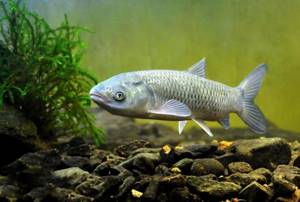
This fish eats plants
It was the fact of eating vegetation that interested environmental safety advocates and energy workers, who had no idea what to do with silted cooling ponds at large industrial facilities.
In this video you will learn what harms fish:
https://youtube.com/watch?v=gfOI1o6FVno
Some algae that could not be removed by any means (for example, Elodea) were successfully destroyed and significantly reduced in volume thanks to grass carp.
